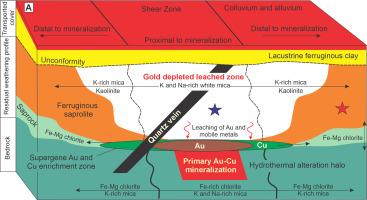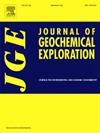Mapping hydrothermal alteration in regolith using white micas and chlorite as vectors towards gold mineralization
IF 3.4
2区 地球科学
Q1 GEOCHEMISTRY & GEOPHYSICS
引用次数: 0
Abstract
Mineral exploration through regolith-dominated terrains poses a significant challenge to cost-effective exploration techniques. Due to missing surface expression, undercover mineral exploration relies on understanding ore-forming processes and characterizing alteration regimes to decipher suitable vectors towards ore deposits. The work presented focuses on the Archean granite-greenstones of the Yilgarn Craton, east of the Meekatharra area in Western Australia, and characterizes the weathering profiles by understanding metal dispersion mechanisms and identifying mineralogical vectors towards gold mineralization within regolith. Mineral mapping of gold mineralization using TESCAN Integrated Mineral Analyzer and laser ablation ICP-MS shows gold is associated with multiple generations of pyrite, and base metal sulfides and sulfosalts hosted in felsic to intermediate volcanics and volcaniclastics. Intensive weathering generated a thick regolith profile dominated by a leached zone of kaolinitic and micaceous saprolite underlain by a supergene Au-Cu deposit blanket at the base. The supergene deposit is dominated by colloform and framboidal pyrite, with pure microcrystalline Au, chalcocite, bornite, malachite, and alunite. Hyperspectral analyses were used to trace the composition and abundance of chlorite and white mica variations in the host rock and the weathering profile. The mineral assemblage in the hydrothermal alteration halo proximal to and intersecting gold mineralization is dominated by Fe-rich chlorite and Na-rich white mica (paragonite). Fe-rich chlorite and paragonite are spatially tied to elevated Au concentration and trends to Fe-Mg-rich chlorite and K-rich white mica (muscovite) distal to the alteration. The variations in chlorite chemistry were detected mainly in bedrock and saprock. Conversely, the white mica chemistry variations were detected in bedrock and the regolith profile, in which white micas resist intensive weathering. The spectral signatures identified through short-wave and thermal infrared data are verified through X-ray diffraction, mineral chemistry, and bulk geochemical analyses. This distinctive spectral signature of white mica and chlorite is a cost-effective exploration method for regional mapping of mineral systems to identify hydrothermal alteration footprints in the regolith developed over felsic and intermediate rocks.

利用白云母和绿泥石作为金矿化的载体,绘制摄虏岩热液蚀变图
通过以碎屑岩为主的地形进行矿产勘探,对具有成本效益的勘探技术提出了重大挑战。由于地表表达缺失,地下矿产勘探有赖于了解矿石形成过程和蚀变机制特征,以破译通往矿床的合适路径。本文介绍的工作重点是西澳大利亚米卡塔拉地区以东 Yilgarn 克拉顿的 Archean 花岗岩-绿岩,通过了解金属弥散机制和确定碎屑岩中金矿化的矿物学载体,描述风化剖面的特征。使用 TESCAN 集成矿物分析仪和激光烧蚀 ICP-MS 绘制的金矿化矿物图显示,金与长英质至中英质火山岩和火山碎屑岩中的多代黄铁矿、贱金属硫化物和硫化物有关。强烈的风化作用产生了厚厚的风化岩剖面,该剖面以高岭土和微粒灰质吸水岩浸蚀带为主,底部则是超生金-铜矿床毯。该超生矿床主要由胶状黄铁矿和框架黄铁矿组成,并伴有纯微晶金、黄铜矿、辉铜矿、孔雀石和褐铁矿。高光谱分析用于追踪主岩和风化剖面中绿泥石和白云母的成分和丰度变化。热液蚀变晕中接近金矿化并与之相交的矿物组合主要是富含铁的绿泥石和富含 Na 的白云母(paragonite)。富铁绿泥石和副皂石在空间上与金浓度的升高有关,在热液蚀变远端则向富铁镁绿泥石和富钾白云母(白云母)的方向发展。绿泥石化学成分的变化主要在基岩和边岩中发现。相反,白云母化学变化则在基岩和沉积岩剖面中检测到,其中白云母可抵抗强烈的风化作用。通过短波和热红外数据确定的光谱特征通过 X 射线衍射、矿物化学和块体地球化学分析得到了验证。白云母和绿泥石的这种独特光谱特征是一种具有成本效益的勘探方法,可用于绘制区域矿物系统图,以确定在长英岩和中间岩上形成的残积岩中的热液蚀变足迹。
本文章由计算机程序翻译,如有差异,请以英文原文为准。
求助全文
约1分钟内获得全文
求助全文
来源期刊

Journal of Geochemical Exploration
地学-地球化学与地球物理
CiteScore
7.40
自引率
7.70%
发文量
148
审稿时长
8.1 months
期刊介绍:
Journal of Geochemical Exploration is mostly dedicated to publication of original studies in exploration and environmental geochemistry and related topics.
Contributions considered of prevalent interest for the journal include researches based on the application of innovative methods to:
define the genesis and the evolution of mineral deposits including transfer of elements in large-scale mineralized areas.
analyze complex systems at the boundaries between bio-geochemistry, metal transport and mineral accumulation.
evaluate effects of historical mining activities on the surface environment.
trace pollutant sources and define their fate and transport models in the near-surface and surface environments involving solid, fluid and aerial matrices.
assess and quantify natural and technogenic radioactivity in the environment.
determine geochemical anomalies and set baseline reference values using compositional data analysis, multivariate statistics and geo-spatial analysis.
assess the impacts of anthropogenic contamination on ecosystems and human health at local and regional scale to prioritize and classify risks through deterministic and stochastic approaches.
Papers dedicated to the presentation of newly developed methods in analytical geochemistry to be applied in the field or in laboratory are also within the topics of interest for the journal.
 求助内容:
求助内容: 应助结果提醒方式:
应助结果提醒方式:


